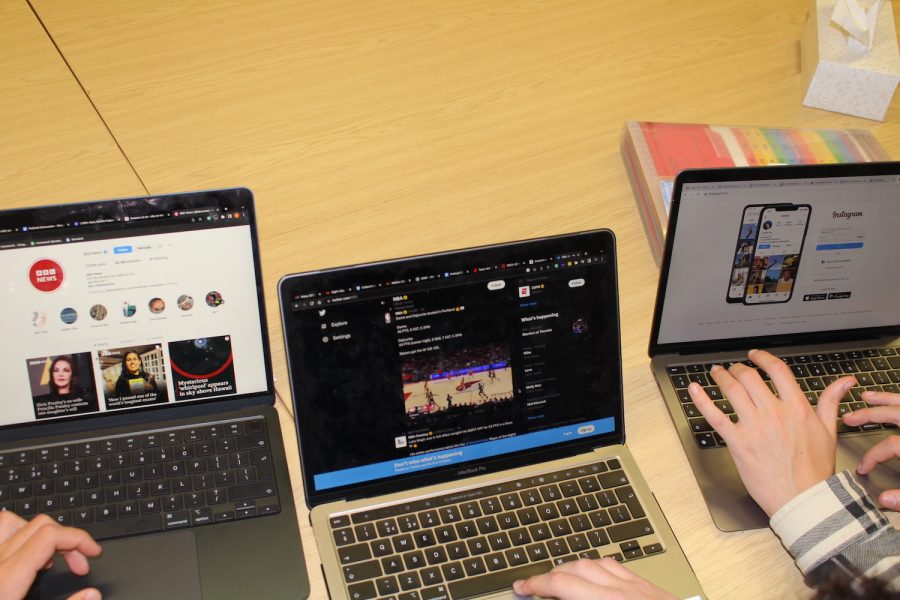Several social media platforms display news stories, among other uses. Whether scrolling across Instagram, Tiktok or other platforms, one may come across a news announcement or broadcast.
Mallika Kapur (P’25), a journalist at Bloomberg News, said multimedia platforms are crucial to reach an international audience.
“News needs an outlet, so I think any form of media becomes a really important vehicle to get the news across,” Kapur said. “Whether it’s media in terms of TV, social media platforms, radio, live news, without these various multimedia platforms we really couldn’t get the news out. So I think it’s absolutely crucial to spread news and reach a global audience.”
Head Librarian Karen Field said across social media, people intake many examples of false information everywhere – namely in politics, health and news – and it exhibits how easily people can be persuaded. In the past, Field said there was disinformation and other dangers of social media, but not to the current extent and speed.
Kapur said news displayed on social media also encourages dangerously high levels of misinformation.
As a result of living in the digital age, Kapur said Generation Z is more prone to use social media platforms for news than older generations. Kapur said since the COVID-19 pandemic, worldwide misinformation has rapidly spread.
Following the pandemic, where the social media usage increased during isolation, Field said news on the science of COVID-19 sparked misinformation.
“There are all remedies and cures and health stuff coming from people with no expertise, and they’re promoting some unhealthy things, actually, that doctors are worried about,” Field said.
Field said the rise of news on social media has both positive and negative impacts on the media.
“The good can be the immediacy, but at the same time, the immediacy can be a bad thing because nothing has been checked or vetted,” Field said.
Similarly, Sinan De Cabrol (’25) said social media is valuable in terms of news because of the urgency, but it can be problematic when multiple users can supply information that may unverified.
“Wikipedia is a good example of this, because even though it’s not social media, similarly it’s a form where people can input information and edit things at their own will which can be detrimental when you are in need of factual information,” De Cabrol said.
Justin Shaya (’26) said he avoids encountering fake news on social media by following verified news organization accounts, such as CNN and BBC, and checks several to gain an understanding of different perspectives.
Shaya said he recognizes one danger of news on social media is several accounts release false information for the sake of view count or persuasion.
“It’s important to be educated about having good sources because different sources give different information,” he said. “You want the most real information … not every source is going to give you a plain out story, they’re going to have their individual views.”
Tessa Nussenbaum (’26) said information across social media spreads quickly, which is why false rumors and inaccurate, distorted and unreliable information are very threatening.
Kapur said her relatives living in India receive countless pieces of misleading information through social media that can be detrimental as it can give people a false sense of what is true. She said it is crucial that when people read news to verify by looking at other sources.
“India really thrives on WhatsApp and there’s a lot of misinformation that spreads via WhatsApp,” Kapur said. “My dad always ends up getting a lot of them on his phone, and he will always forward them to me, and eight out of 10 times it is misinformation. That’s really the danger of it, people who don’t have the resources to verify whether it is true or not.”
Field said social media thrives on algorithms catered to individual users, creating similar posts which provide only one perspective. She said users can unintentionally end up with a feed of fake news or news showing a one-sided opinion.
“If I for a while just looked at horse videos for the longest time when I don’t even own a horse, I must have watched one for too long,” Field said. “You get stuck in only seeing the same thing … I don’t think that’s always really healthy to see the same ideas presented over and over again.”
De Cabrol said he utilizes social media for less news-based content due to the biases it may hold. Additionally, he said he receives news from family, friends and other credible sources.
“Social media is probably one of the worst places to get especially political news,” he said. “People can twist stories to make their side more favorable, which makes it very unreliable.”
Nussenbaum said she has seen examples of misinformation in school and on social media and has also been taught how to avoid it via verifying sources, preventing her from becoming easily swayed.
“It’s never really affected me directly because I’ve learned not to trust everything I see,” Nussenbaum said. “[I see if] it doesn’t come from a credible source.”
Shaya similarly said he had learned about misinformation in the media in previous school years. He said he was taught not to be a “bystander” and to “help other people from intaking misinformation” of news on social media.
Although the dangers of social media are not directly taught to students, Field said it is intertwined with the curriculum within many subjects at school. She said World Civilizations I, II, Health and Middle School classes often touch on illogical fallacies, language and arguments through the lens of media.
“You all see it all the time, how manipulative social media can be … really anything online,” Field said. “If we aren’t teaching you how to be critical thinkers of everything you see on the internet, then we’re not doing our job.”





